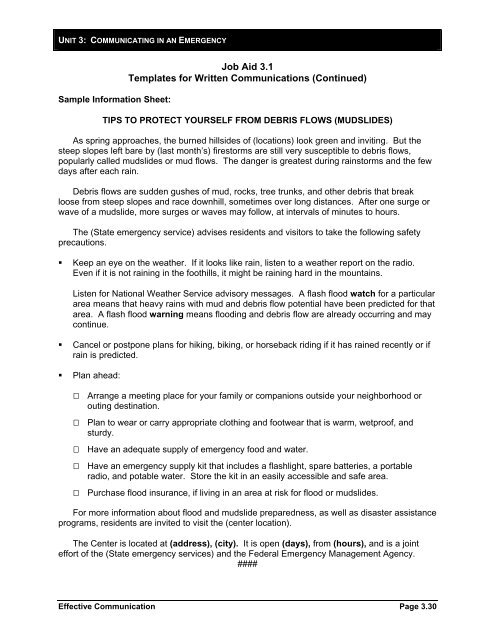Effective Communication - Emergency Management Institute ...
Effective Communication - Emergency Management Institute ...
Effective Communication - Emergency Management Institute ...
Create successful ePaper yourself
Turn your PDF publications into a flip-book with our unique Google optimized e-Paper software.
UNIT 3: COMMUNICATING IN AN EMERGENCY<br />
Sample Information Sheet:<br />
Job Aid 3.1<br />
Templates for Written <strong>Communication</strong>s (Continued)<br />
TIPS TO PROTECT YOURSELF FROM DEBRIS FLOWS (MUDSLIDES)<br />
As spring approaches, the burned hillsides of (locations) look green and inviting. But the<br />
steep slopes left bare by (last month’s) firestorms are still very susceptible to debris flows,<br />
popularly called mudslides or mud flows. The danger is greatest during rainstorms and the few<br />
days after each rain.<br />
Debris flows are sudden gushes of mud, rocks, tree trunks, and other debris that break<br />
loose from steep slopes and race downhill, sometimes over long distances. After one surge or<br />
wave of a mudslide, more surges or waves may follow, at intervals of minutes to hours.<br />
The (State emergency service) advises residents and visitors to take the following safety<br />
precautions.<br />
Keep an eye on the weather. If it looks like rain, listen to a weather report on the radio.<br />
Even if it is not raining in the foothills, it might be raining hard in the mountains.<br />
Listen for National Weather Service advisory messages. A flash flood watch for a particular<br />
area means that heavy rains with mud and debris flow potential have been predicted for that<br />
area. A flash flood warning means flooding and debris flow are already occurring and may<br />
continue.<br />
Cancel or postpone plans for hiking, biking, or horseback riding if it has rained recently or if<br />
rain is predicted.<br />
Plan ahead:<br />
Arrange a meeting place for your family or companions outside your neighborhood or<br />
outing destination.<br />
Plan to wear or carry appropriate clothing and footwear that is warm, wetproof, and<br />
sturdy.<br />
Have an adequate supply of emergency food and water.<br />
Have an emergency supply kit that includes a flashlight, spare batteries, a portable<br />
radio, and potable water. Store the kit in an easily accessible and safe area.<br />
Purchase flood insurance, if living in an area at risk for flood or mudslides.<br />
For more information about flood and mudslide preparedness, as well as disaster assistance<br />
programs, residents are invited to visit the (center location).<br />
The Center is located at (address), (city). It is open (days), from (hours), and is a joint<br />
effort of the (State emergency services) and the Federal <strong>Emergency</strong> <strong>Management</strong> Agency.<br />
####<br />
<strong>Effective</strong> <strong>Communication</strong> Page 3.30

















